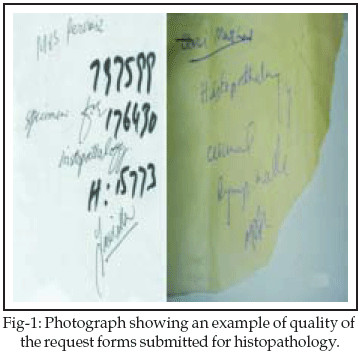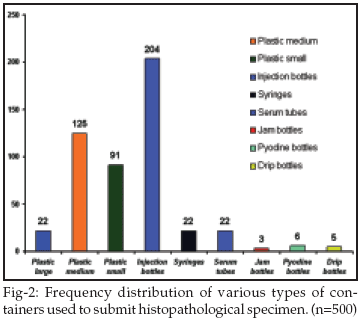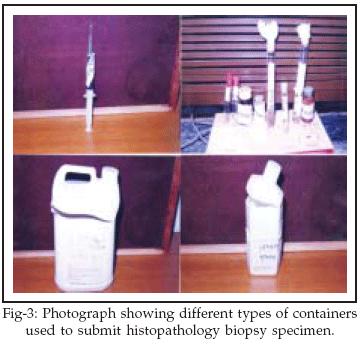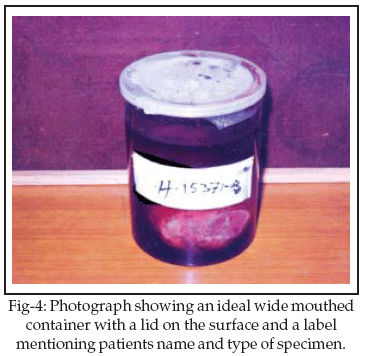|
|
||||
|
Published by : PROFESSIONAL MEDICAL PUBLICATIONS |
||||
|
ISSN 1681-715X |
||||
|
||||
|
- |
||||
|
ORIGINAL ARTICLE |
||||
|
- |
||||
|
Volume 23 |
October - December 2007 (Part-I) |
Number 5 |
||
|
|
||||
|
|
||||
|
|
||||
|
Published by : PROFESSIONAL MEDICAL PUBLICATIONS |
||||
|
ISSN 1681-715X |
||||
|
||||
|
- |
||||
|
ORIGINAL ARTICLE |
||||
|
- |
||||
|
Volume 23 |
October - December 2007 (Part-I) |
Number 5 |
||
|
|
||||
|
|
||||
Clinicianís Responsibility in Pre-Analytical
Quality Assurance of Histopathology
Muhammad Ashraf Sharif1, Sajid Mushtaq2,
Nadira Mamoon3,
Shahid Jamal4, Muhammad Luqman5
ABSTRACT
Objective: To ascertain the adequacy of information provided by clinicians when requesting a histopathology investigation and to study the quality control parameters of the specimen containers.
Methodology: This is an observational descriptive study which was carried out at Armed Forces Institute of Pathology in December 2006 on 500 specimen requests for histopathology.
Results: Out of 500 specimens, age was not mentioned in 29 (5.8%) cases. No clinical history or differential diagnosis was given in 170 (34%) cases. Site of biopsy was absent in 65 (13%) cases and the name of requesting clinician or any contact information was present in only 115 (23%) of request forms. One hundred forty three (28.7%) containers were inadequate relative to the size of the specimen. Adequate volume of fixative was absent in 176 (38.2%) samples. There were 22 (4.3%) samples which did not have any sort of label mentioning either patientís name or type of specimen. Injection bottles constituted the highest number of containers (n=204; 40.8%) used to submit the histopathology specimen.
Conclusion: Clinicians of all grades and specialties must be educated and made aware of their primary responsibility to request the service appropriately for the benefit of the patient and patient care.
KEY WORDS: Quality control, Histopathology, Specimen.
Pak J Med Sci October - December 2007 (Part-I) Vol. 23 No. 5 720-723
1. Muhammad Ashraf Sharif,
2. Sajid Mushtaq,
3. Nadira Mamoon,
1-3: Dept. of Histopathology AFIP, Rawalpindi - Pakistan.
4. Shahid Jamal,
Army Medical College, Rawalpindi - Pakistan.
5. Muhammad Luqman,
Foundation Medical College,
Rawalpindi Ė Pakistan.
Correspondence
Dr. Muhammad Ashraf Sharif
E-mail: ashrafof@gmail.com
* Received for Publication: March 20, 2007
* Accepted August 12, 2007
INTRODUCTION
Medical laboratory practice has changed and developed beyond recognition over recent years.1 An increase in the level and technological sophistication of medical interventions has increased the workload and demand.2 Changes in the attitudes and expectations from the users demand faster turn around time. The size of the biopsies is getting smaller and the expectations are getting higher. Elimination of outdated, redundant and unnecessary laboratory work can improve laboratory and reporting standards.3Demands placed on histopathologists have risen because of the complexity in surgical pathology reports as per guidelines mentioning the prognostic parameters and resection margins where indicated.
4,5 Histopathologists perceive that clinicians do not understand the working of histopathology departments. This is based on the poor quality of requests & specimen received for histopathology investigations.6,7 We studied the adequacy of information provided by clinicians when requesting a histopathology investigation. Also studies were the quality control parameters of the containers in which the specimen were submitted.MATERIALS AND METHODS
This observational descriptive study was carried out at Armed Forces Institute of Pathology (AFIP), Rawalpindi. AFIP is a reference laboratory with an annual histopathology workload of 25,000 biopsy specimen. Specimens are received from adjoining military hospitals, civil and private hospitals of upper Punjab and North West Frontier Province. Five hundred sequential requests for histopathology examination were included in the study conducted during December 2006.
The requesting clinicians were unaware that the data would be recorded and surgical specimen will be evaluated for quality control parameters. Requests for cytological examination were excluded form the study as they do not require routine histopathology processing.
Each request form was assessed for the presence & completeness of information regarding;
a) Patientís demographic data (age, gender)
b) Clinical history or differential diagnosis
c) Site of biopsy
d) Description of specimen
e) Name of referring clinician or contact number and signature
The corresponding specimen with each request form was also evaluated for quality control parameters. The parameters studied were:
a) Size of the container relative to the specimen size
b) Volume of the fixative at least three times the size of the specimen
c) Identification label on the container mentioning patientís name and or specimen
The type of containers which were used for sending the specimen to the laboratory for histopathological evaluation was also studied.
RESULTS
Out of 500 specimens, age was not mentioned in 29 (5.8%) cases and gender was missing in 70 (14%) request forms. No clinical history or differential diagnosis was given in 170 (34%) cases (Fig-1). Site of biopsy was absent in 65 (13%) cases. The name of requesting clinician or any contact information was present in only 115 (23%) of request forms.

As regards the containers which were used for sending the biopsy specimen, there were 143 (28.7%) of them which were inadequate relative to the size of the specimen. Adequate volume of fixative was absent in 176 (38.2%) samples. There were 22 (4.3%) samples which did not have any sort of label mentioning either patientís name or type of specimen.

There was diversity in the different types of containers which were used for sending the specimen to the laboratory (Fig-2). These included plastic jars, injection bottles, syringes, serum tubes, jam bottles, cut open pyodine and intravenous drip bottles (Fig-3).

Injection bottles constituted the highest number of containers (n=204; 40.8%) used to submit the histopathology specimen.
DISCUSSION
Histopathology services should be used appropriately to avoid redundancy. Clinicians providing insufficient information about themselves and their patients generate redundancy within the services.
7 The demographic data helps in identification and search for any other previous investigations through laboratory computer software. Age and gender helps in the differential diagnosis of the lesions.7Nature of the specimen helps to prevent identification errors during processing. The knowledge of the test required helps to direct the sample to the appropriate department.
8 A renal biopsy for immunofluorescence may be prevented form being processed for histopathology. Likewise a lymph node for microbiological culture may be processed for histopathology erroneously. Furthermore, special staining techniques can be applied to tailor the report to clinicianís needs.In our study there were 34% cases where clinical details were absent all together. This is much higher than the similar studies carried in the West by Nakleh et al,
9 as 2.4% and Burton et al,7 as 6.1%. Consultants are likely to provide more information than the residents. Amongst consultants physicians provide detailed information than the surgeons.7 Absence of clinical information or misleading diagnosis leads to extraneous, unnecessary additional tests or application of broad spectrum immunohistochemical stain panels. This has definite resource management and demand implications.Contact information of the doctors was missing in 73% cases and is higher than reported by Burton et al
7 and Nakleh et al.9 Details regarding the name and contact information of the clinicianís can be helpful in obtaining additional clinical information. Absence of this impedes the diagnostic process and leads to delay in reporting.10 Ideally all specimen should be accompanied by relevant and adequate clinical information.The specimen submitted to the laboratory should ideally be in a wide mouthed container with a lid on the surface (Fig-4).

There should be adequate free space in the container so that it does not distort the shape and anatomy of the specimen. Specimen tend to get firm to hard after fixation and it may not be possible to extract the specimen out of a narrow mouthed container. The container might have to be cut in case of plastic or broken in cases of glass bottles or containers. This practice puts the pathologist and his staff technicians at risk from injuries through broken glass or while cutting plastic. Moreover spilled over small pieces of glass may get embedded with the specimen in the cassettes causing damage to the microtome during sectioning. About 29% of the containers were inadequate relative to the size of the specimen which is a fairly large number. This is an alarming proportion and clinicianís should take immediate measures to rectify this discrepancy for the benefits of the patients and safety of their fellow pathologists.
Quality of the sections made from the tissue depends upon their adequate fixation. Ideally the volume of the fixative should be ten times the specimen and in an adequate container. In the present study 35.2% specimen did not have any or very little amount of fixative in the containers. This not only results in the autolysis of the tissue but also causes loss of morphological features. Moreover immunohistochemical stain results are also poor on such tissue sections. Thus, tissue which is very vital to the diagnosis becomes useless and may have serious consequences on the subsequent management, requiring rebiopsy, or fatal at times due to the inordinate delay in specific diagnosis.
Proper identification and orientation are imperative for the adequate pathological evaluation of the case. An unlabelled specimen should never be processed. If a biopsy is received in a laboratory without identification, the physician or his assistant should be called to identify and label the specimen.
11 Four percent cases did not have any label on the specimen and of all 70% did not have their clinicianís name on the request form. This results in undue delays and unnecessary increased managerial workload affecting the routine quality working of a laboratory.Syringes, drip bottles, cut open Pyodine bottles, injection bottles and test tubes are bad examples of specimen containers. They not only distort the anatomy of the specimen but may also result in spillage of the fixative and even loss of precious specimen during transportation. These containers constituted 47% in our study and reflect badly on the management skills of the clinicians. Plain serum tubes with tightly fitted caps are only good enough for the punch skin biopsies, mucosal biopsies on filter paper and trucut biopsy provided they have a label on the surface for identification.
Before undertaking any biopsy or surgical procedure, an adequate container having reasonable amount of fixative with proper labeling should be at hand. A request form indicating relevant patient and clinical information should be filled either before hand or after the procedure in a responsible way.
CONCLUSION
The specimen with the request form is the first contact of a clinician with histopathology department. Failure to provide the requisite information prevents the pathologist to assess the appropriateness of the investigation. Greater stress is placed on the laboratory management and staff in gathering the necessary information for the benefit of the patient. Clinicians of all grades and specialties must be educated and made aware of their primary responsibility to request the investigations appropriately for the benefit of the patient and patient care.
REFERENCES
1. Bird C. Shedding the shackles. Medical Laboratory Worker May 2003;13-7.
2. Bailey J, Jennings A, Prapia L. Change of pathology request forms can reduce unwanted results and tests. J Clin Pathol 2005;58:853-5.
3. Gambino SR. The problem of outdated, redundant or unnecessary laboratory tests: laboratory triage, a suggested solution. Can J Med Technol 1969;31:5-8.
4. Shorrock K. Use of histopathology services by general practitioners: recent changes in referral practice. J Clin Pathol 1993;46:989-92.
5. Cross SS, Bull AD. Is the informational content of histopathological reports increasing? J Clin Pathol 1992;45:179-80.
6. Nicol A. Pathologically high blood pressure. ACP News1998 (Winter):33-8.
7. Burton JL, Stephenson TJ. Are clinicians failing to supply adequate information when requesting a histopathological investigation? J Clin Pathol 2001;54;806-8.
8. Burton JL, Goepel JR, Lee JA. Great expectorations: demand management of sputum cytology leads to 86% reduction. J Pathol 2000;190:54A.
9. Nakhleh RE, Zarbo RJ. Surgical pathology specimen identification and accessioning: a College of American Pathologists Q-Probes study of 1 004 115 cases form 417 institutions. Arch Pathol Lab Med 1996;120:227-33.
10. Nakhleh RE, Gephardt G, Zarbo RJ. Necessity of clinical information in surgical pathology: a College of American Pathologists Q-Probes study of 771 475 surgical pathology cases from 341 institutions. Arch Pathol Lab Med 1999;123:615-9.
11. Rosai J. Gross techniques in surgical pathology. In: Juan Rosai, editor; Rosai and Ackermanís Surgical Pathology. London, UK. Mosby; 2004;25-36.
HOME | SEARCH | CURRENT ISSUE | PAST ISSUES
Professional
Medical Publications
Room No. 522, 5th Floor, Panorama Centre
Building No. 2, P.O. Box 8766, Saddar, Karachi - Pakistan.
Phones : 5688791, 5689285 Fax : 5689860
pjms@pjms.com.pk